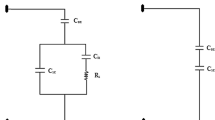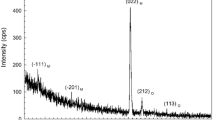Abstract
The dielectric properties of metal–oxide–semiconductor Al/SiO2/p-Si, MOS, heterojunction were studied in the frequency range 40 Hz–20 MHz and in the temperature range 30–90C using 1 Vrms test signal. Experimental results verified that various dielectric parameters and ac conductivity (sac) are strong function of frequency and temperature. The values of both real and imaginary parts of permittivity, e′, e″ respectively, decrease with increasing frequencies owing to the fading of interface states of oxide layer SiO2 capacitance effect with increasing frequency. On the other hand, the ac conductivity rises with both frequency and temperature. This paper is concerned with the impact of epitaxial growth as a manufacturing method on the physical properties of resulting device compared to the other methods from literature. Epitaxial growth proved to make a heterostructure that has an intermediate conductivity between metals and semiconductors having the latter’s behaviour. In addition, the resulting device has more consistent capacitance that is almost temperature independent within the temperature and frequency ranges measured in the experiment. This simply means the device function persuades the manufacturer to prefer certain preparation methodology over another to perform certain function.
Similar content being viewed by others
References
Sze SM (1981) Physics of semiconductor devices, 2nd edn. Wiley, New York
Rhoderick EH, Williams RH (1988) Metal–semiconductor contacts, 2nd edn. Oxford University Press, Oxford
Nicollian EH, Brews JR (1982) MOS physics and technology. Wiley, New York
Werner JH (1988) Schottky barrier pn-junctionI/V plots—Small signal evaluation. Appl Phys A 47(3):291–300
Hudait MK, Krupanidhi SB (2000) Effects of thin oxide in metal–semiconductor and metal–insulator–semiconductor epi-GaAs Schottky diodes. Solid-State Electron 44:1089
Schottky W (1938) Semiconductor theory of the barrier layer. Naturwissenchaften 26:843
Mott NF (1938) Note on the contact between a metal and an insulator or semiconductor. Proc Camb Philos Soc 34:568–572
Chattopadhyay P (1994) Effect of localized states on the current-voltage characteristics of metal-semiconductor contacts with thin interfacial layer. Solid State Electron 37:1759
Singh A (1985) Characterization of interface states at Ni/nCdF2 Schottky barrier type diodes and the effect of CdF2 surface preparation. Solid-State Electron 28(3):223
Cova P, Singh A, Masut RA (1997) A self-consistent technique for the analysis of the temperature dependence of current–voltage and capacitance–voltage characteristics of a tunnel metal-insulator-semiconductor structure. J Appl Phys 82:5217
Deuling H, Klausmann E, Goetzberger A (1972) Interface states in Si–SiO2 interfaces. Solid-State Electron 15(5):559
Castagne R, Vapaille A (1971) Description of the SiO2–Si interface properties by means of very low frequency MOS capacitance measurements. Surf Sci 28(1):157
Kelberlau U, Kassing R (1979) Theory of nonequilibrium properties of MIS capacitors including charge exchange of interface states with both bands. Solid-State Electron 22(1):37
Nicollian EH, Goetzberger A (1965) Mos conductance technique for measuring surface state parameters. Appl Phys Lett 7:216
Das S, Das S, Sutradhar S (2017) Enhanced dielectric behavior and ac electrical response in Gd-Mn-ZnO nanoparticles. J Alloys Compd 726:11–21
Das S, Bandyopadhyay A, Saha P, Das S, Sutradhar S (2018) Enhancement of room-temperature ferromagnetism and dielectric response in nanocrystalline ZnO co-doped with Co and Cu. J Alloys Compd 749:1–9
Henni A, Mberrouche A, Telli L, Karar A (2016) Studies on the structural, morphological, optical and electrical properties of Al-doped ZnO nanorods prepared by electrochemical deposition. J Electroanal Chem 763:149–154
Wang J, Or SW, Tan J (2018) Enhanced microwave electromagnetic properties of core/shell/shell-structured Ni/SiO2/polyaniline hexagonal nanoflake composites with preferred magnetization and polarization orientations. Mater Des 153:190–202
Stegemann B, Sixtensson D, Lussky T, Schoepke A, Didschuns I, Rech B, Schmidt M (2008) Ultrathin SiO2 layers on Si(111): preparation, interface gap states, and influence of passivation. Nanotechnology 19:424020
Ashery A, Farag AAM, Mahani R (2010) Structural, electrical and magnetic characterizations of Ni/Cu/p-Si Schottky diodes prepared by liquid phase epitaxy. Microelectron Eng 87:2218–2224
Jain VV (2007) Microstructure and properties of copper thin films on silicon substrates, Master of Science, Texas A&M University
Akkal B, Benamara Z, Gruzza B, Bideux L (2000) Characterization of interface states at Au/InSb/InP(100) Schottky barrier diodes as a function of frequency. Vacuum 57:219
Haase F, Neubert T, Horbelt R, Terheiden B, Brendel R (2011) Local aluminum–silicon contacts by layer selective laser ablation. Sol Energy Mater Sol Cells 95:2698–2700
Chen T-S, Hsueh Y-C, Chiou S-E, Shiue S-T (2015) The effect of the native silicon dioxide interfacial layer on photovoltaic characteristics of gold/p-type amorphous boron carbon thin film alloy/silicon dioxide/n-type silicon/aluminum solar cells. Sol Energy Mater Sol Cells 137:185–192
Tataroglu A, Yucedag I, Altindal S (2008) Dielectric properties and ac electrical conductivity studies of MIS type Schottky diodes at high temperatures. Microelectron Eng 85:1518–1523
Ranga Raju MR, Choudhary RNP, Ram S (2003) Dielectric and electrical properties of Sr5EuCr3Nb7O30 nanoceramics prepared using a novel chemical route. Phys Status Solidi (b) 239(2):480
Singh V, Kulkarni AR, Rama Mohan TR (2003) Dielectric properties of aluminum–epoxy composites. J Appl Polym Sci 90:3602
Maurya D, Kumar J, Shripal (2005) Dielectric-spectroscopic and a.c. conductivity studies on layered Na2-XKXTi3O7 (X = 0.2, 0.3, 0.4) ceramics. J Phys Chem Solids 66:1614
Yildiz DE, Dokme I (2011) Frequency and gate voltage effects on the dielectric properties and electrical conductivity of Al/SiO2/p-Si metal-insulator-semiconductor Schottky diodes. J Appl Phys 110:014507
Author information
Authors and Affiliations
Corresponding author
Ethics declarations
Conflict of interest
Authors declare that No conflict of interest.
Rights and permissions
About this article
Cite this article
Ashery, A., Elnasharty, M.M.M. Dielectric Assessment of Epitaxially Grown Al/SiO2/Si Heterojunction. Silicon 11, 1875–1883 (2019). https://doi.org/10.1007/s12633-018-0006-y
Received:
Accepted:
Published:
Issue Date:
DOI: https://doi.org/10.1007/s12633-018-0006-y




